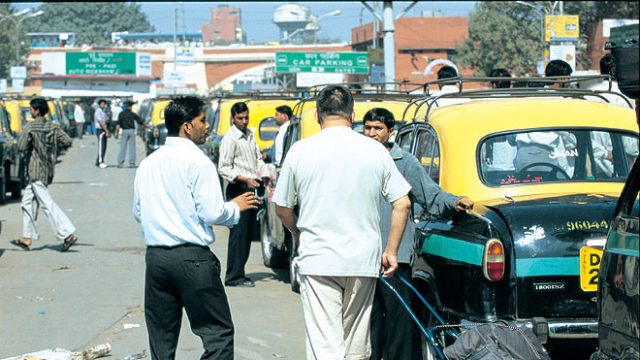Horror stories about Delhi’s taxis and autorickshaws are legion. The classic trick of the trade, unfolds as with all good horror stories in the dead of night. The victim is generally a foreigner or an Indian new to Delhi arriving at the International Airport, who is shanghaied into a ‘cheap’ ride by a swarm of taxi drivers. On a more routine (and more prosaic) basis meters are fiddled, straightforward journeys are taken by circuitous routes and any protest invites abuse or plain refusal to take you to your destination. Though every traveller is for them fare game, the worst hit are the uninitiated passengers who arrive at Delhi’s airports and railway stations.
The pre-paid autorickshaw and taxi service in Delhi was started as an effort to discipline Delhi’s cabbies and curb rampant overcharging. The principle is simple, you land up at the pre-paid taxi/autorickshaw counter, mention your destination, and pay a charge which is determined by distance range. The staff at the pre-paid counter will hand you a receipt slip which lists the number of your taxi or autorickshaw, and is to be handed over to the driver once you reach your destination. In practice however, things are a little more difficult. To find how just how difficult I decided to place myself in the unenviable position of the newly arrived.
The first leg of my expedition took me from Safdarjung Enclave to the Hazrat Nizammudin railway station. Rates varying from Rs40 to Rs70 were quoted, and the common refrain was “sahib, these electronic meters are so unreliable, hit a pothole and they stop. I am charging you the actual rate”. I finally settled at Rs50. “Why do you want to go by the meter, anyway?”, queried my autorickshaw driver, “most of these electronic meters are fiddled to go at twice the normal rate”. When I protested that the electronic meters were tamper proof, he gave me a look of utter disbelief and my first lesson in how to fiddle meters. “The mechanical meters”, he continued, “could be made to go a little faster, maybe four, five rupees—we paid Rs5,000 for these ones, and we have to bribe the transport department personnel at Burari Rs300 to have them passed.” This was followed by a long lecture on the economics of auto-rickshaw driving, the parting shot of which was “we are honest people, sir. We may overcharge by Rs10 at the maximum, but then we’ve got to earn a living too.” He was true to his word—the meter showed Rs41.
The pre-paid autorickshaw stand at the Nizammudin station is close to the exit. The area though is quite a mess, and there’s a horde of auto drivers who stand around the prepaid booth. After a little snooping around I found Yogendra Srivastava, head of the BJP affiliated taxi operators union of the Nizammuddin station. According to him, there are 40 to 50 private cars which operate illegally from the station. “These dalals”, he confided, “pay the police here a ‘mahina’ (monthly bribe) of Rs4,000. They solicit customers from the platform itself, and tell them that there is no pre-paid taxi service at the station. They cheat passengers by promising them ridiculously low rates initially, but they then take them to guest houses and hotels they are in cahoots with, or demand much higher rates once they’ve got the passenger in their cars.” Mr Srivastava then handed me a copy of complaints he’d made to the Commissioner of Transport. “Nothing happened”, he said. Just then the Mangla Express disgorged it’s passengers and I made a beeline for the pre-paid booth.
Once you get to the pre-paid booth things seem to go fairly smoothly, though there is no pre-paid taxi service available. The taxi drivers however are willing to go by meter (though that’s not saying much). The pre-paid autorickshaw (and taxi) rates are a little higher than meter rates, but it saves on the haggling, and ensures that you are dropped at the doorstep, as difficult as the address may be to find. Night services though can be erratic, with drivers hesitant to go to off-beat places, and in such situations the cops and prepaid booth staff will both more often than not abdicate duty.
The situation at Nizammuddin is replicated with a few minor changes at the New Delhi and Old Delhi railway stations—in fact the soliciting at railway platforms here is even more aggressive. There is a prepaid taxi and autorickshaw booth at the Ajmeri gate side, which is located some distance from the exit. A private taxi operator who (quite conveniently, and probably profitably)has his booth right opposite the exit runs “20 cabs instead of the 10 that he has permission for”, according to Rajkumar, the taxi driver who took me from New Delhi to the Old Delhi railway station. “I’m glad we have a prepaid taxi service here”, he added, “the touts can’t overcharge people, and we don’t have to compete with them since passengers come directly to the prepaid counter.” The Old Delhi railway station has a hard to find and dilapidated prepaid booth which however, does seem to function.
The prepaid operates best at the Domestic Airport though. Service is prompt and you don’t have to go dodging cars to get to your cab. And now we come a full circle to where I started out—the International Airport. The official (Traffic Police run) prepaid counter has no clear signs and is jostled out by two other privately run operators who charge a lot more. There is another prepaid booth outside the exit lounge, but by then I’m sure many a victim has been snared. There is also the usual hustling swarm of taxi drivers which comes swooping down on you the moment you exit the main lounge. I went there during the day, when few flights are coming in. Things at night, I’m told are a lot lot worse.




